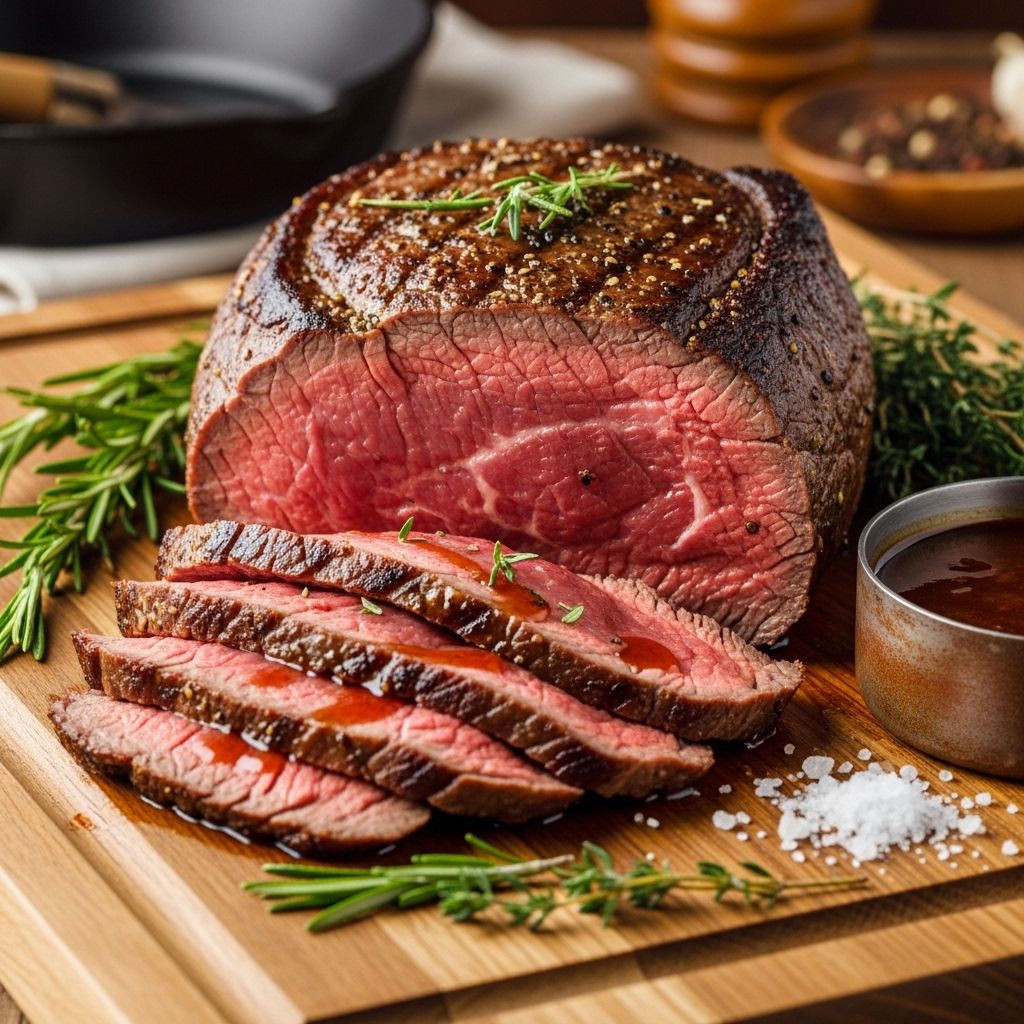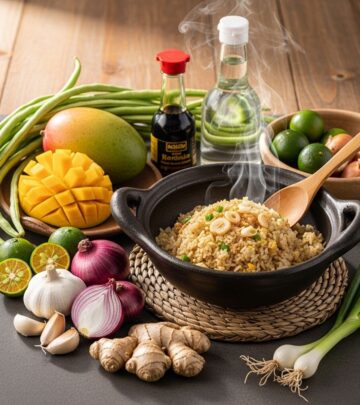Eye Of Round Roast Recipe: 5 Easy Tips For Tender, Juicy Beef
Master the art of perfectly cooked eye of round roast with this deceptively simple high-temperature method

Image: HearthJunction Design Team
High Temperature Eye of Round Roast: Simple Yet Spectacular
The eye of round roast often gets a bad reputation for being tough and flavorless. As an economical cut from the rear leg of the cow, it lacks the marbling found in more expensive cuts. However, with the right cooking technique, this humble cut can be transformed into a tender, juicy, and flavorful masterpiece that rivals fancier cuts at a fraction of the cost. The secret? An unconventional high-temperature cooking method that sears the exterior to perfection while keeping the inside tender and pink.
What Makes This Recipe Special
The magic of this recipe lies in its counterintuitive approach. Rather than the low-and-slow method typically recommended for tougher cuts, this technique starts with an extremely hot oven that creates a flavorful crust, then relies on residual heat to gently cook the interior to the perfect temperature. The result is a roast that’s browned and crispy on the outside while remaining tender and juicy within.
What’s particularly appealing about this method is its simplicity. With just a few basic ingredients – the roast itself, salt, and pepper – you can create a meal that tastes like it came from a high-end steakhouse. The minimal handling and hands-off cooking process make it perfect for both beginner cooks and seasoned chefs looking for a reliable, no-fuss recipe.
Understanding the Cut: Eye of Round Roast
The eye of round comes from the rear leg of the cow, specifically from the round primal cut. This working muscle is lean with minimal fat marbling, which traditionally makes it challenging to cook without resulting in tough, dry meat. However, this leanness also makes it a healthier option compared to fattier cuts.
Typically weighing between 2-8 pounds, the eye of round is cylindrical in shape with a thin layer of fat on one side. Its uniform shape makes it ideal for even cooking and easy slicing, which is essential for serving since cutting this roast thinly across the grain is key to maximizing tenderness.
The Science Behind High-Temperature Roasting
The cooking method used in this recipe might seem unusual, but it’s grounded in food science. Starting with an extremely hot oven (500°F) creates a Maillard reaction on the surface of the meat, developing complex flavors and forming a crust that seals in juices. When the oven temperature is reduced to 475°F and the roast cooks briefly before the heat is turned off completely, the residual heat in the oven chamber and in the meat itself continues the cooking process gradually.
This approach allows the internal temperature to rise slowly, preventing the muscle fibers from contracting too quickly and squeezing out moisture. The extended rest period in the closed oven (2.5 hours) also allows the proteins in the meat to relax and reabsorb some of the juices, resulting in a more tender texture.
Ingredients You’ll Need
One of the beauties of this recipe is its minimalist approach to ingredients:
- 1 (3-pound) eye of round roast
- Salt, to taste
- Black pepper, to taste
That’s it! While you could certainly add other seasonings like garlic powder, herbs, or spices, part of what makes this recipe special is how it showcases the natural flavor of the beef with just the enhancement of salt and pepper. The high-temperature cooking method creates such a flavorful crust that additional seasonings are entirely optional.
Essential Equipment
To successfully execute this recipe, you’ll need:
- A reliable oven with accurate temperature control
- A roasting pan or baking dish
- A meat thermometer (highly recommended for best results)
- A sharp carving knife for thin slicing
The roasting pan doesn’t need to be anything fancy – a simple baking dish that can withstand high temperatures will work perfectly. Unlike some roasting methods, you won’t need a rack as this roast cooks directly in the pan without added liquid.
Step-by-Step Instructions
Preparation
Begin by allowing your roast to come to room temperature for about 30-60 minutes before cooking. This ensures more even cooking throughout the meat. While the roast is sitting out, preheat your oven to 500°F (260°C). This extremely high temperature is crucial for the initial searing phase.
Season the roast generously with salt and pepper on all sides. Don’t be shy with the seasoning, as this is where much of the flavor comes from. The salt not only adds flavor but helps to draw out some moisture from the surface, which contributes to better browning.
The Cooking Process
Place the seasoned roast in your roasting pan or baking dish. There’s no need to add water, cover the roast, or place it on a rack – it goes directly into the pan uncovered.
Put the roast in the preheated 500°F oven, then immediately reduce the temperature to 475°F (245°C). This slight reduction helps prevent burning while still maintaining the high heat needed for proper searing.
Cook the roast for approximately 7 minutes per pound. For a standard 3-pound roast, this means a cooking time of about 21 minutes. This brief high-heat cooking period creates that delicious outer crust.
Now comes the unconventional part: after the initial cooking period, turn off the oven completely but do not open the door. Allow the roast to remain in the hot oven for 2.5 hours. During this time, residual heat will continue to cook the meat gently. This is where patience becomes important – opening the oven door would release the heat and ruin the cooking process.
Checking Doneness and Serving
After the 2.5-hour resting period, remove the roast from the oven and check that the internal temperature has reached at least 145°F (65°C) for medium-rare. If you prefer your meat more done, you may need to adjust the initial cooking time slightly.
Allow the roast to rest for an additional 10-15 minutes before carving. This resting period is crucial as it allows the juices to redistribute throughout the meat.
When ready to serve, carve the roast into very thin slices against the grain. The thinness of the slices is key to the tenderness of the final dish. A sharp knife makes this process much easier and produces better results.
Tips for Perfect Results
- Don’t skip bringing the meat to room temperature – This helps ensure even cooking from edge to center
- Invest in a good meat thermometer – Temperature is crucial for perfect doneness
- Keep that oven door closed – No peeking during the 2.5-hour rest period!
- Slice as thinly as possible – This makes even a somewhat tough cut feel tender
- Consider the size of your roast – The 7-minutes-per-pound rule works best for roasts between 3-5 pounds
Serving Suggestions
This eye of round roast pairs beautifully with traditional sides like mashed potatoes, roasted vegetables, or a simple green salad. For a complete Sunday dinner, consider serving it with:
- Creamy horseradish sauce or au jus for dipping
- Roasted potatoes seasoned with rosemary and garlic
- Steamed green beans or asparagus
- Yorkshire puddings or dinner rolls
Leftover roast beef makes excellent sandwiches, particularly when sliced very thin. It can also be repurposed into beef stroganoff, stir-fries, or hearty beef and vegetable soups.
Nutritional Benefits
Eye of round is one of the leanest beef cuts available, making this recipe a relatively healthy choice for meat lovers. A 3-ounce serving provides approximately:
- Protein: 24-26 grams
- Fat: 5-7 grams
- Calories: 150-170
It’s also an excellent source of B vitamins, zinc, and iron. The minimal ingredients and lack of added fats or oils in this cooking method keep the nutritional profile focused on the natural benefits of the beef itself.
Variations to Try
While the basic salt and pepper seasoning creates a wonderful roast, you can experiment with these variations:
- Herb-Crusted: Add a coating of mixed herbs like rosemary, thyme, and oregano mixed with olive oil
- Garlic Lover’s: Rub the roast with minced garlic or garlic powder before seasoning
- Spicy: Add cayenne pepper or red pepper flakes to the seasoning mix
- Coffee-Rubbed: Include ground coffee in your seasoning for a deep, complex flavor
Storing and Reheating
Properly stored in an airtight container, leftover eye of round roast will keep in the refrigerator for 3-4 days. For longer storage, wrap tightly and freeze for up to 3 months.
When reheating, remember that additional cooking can dry out the already lean meat. For best results, reheat slices gently in a covered dish with a splash of beef broth or in a steamer. Alternatively, enjoy it cold in sandwiches to preserve the texture and flavor.
Frequently Asked Questions (FAQs)
Q: Why does this recipe use such a high cooking temperature?
A: The high initial temperature quickly sears the outside of the roast, creating a flavorful crust and sealing in juices. The residual heat then gently cooks the interior without drying it out.
Q: Can I use this method for other cuts of beef?
A: This method works best for lean, uniform cuts like eye of round. It’s not ideal for fattier cuts or irregularly shaped roasts as the cooking would be less even.
Q: What if my roast doesn’t reach 145°F after the 2.5-hour rest?
A: If your roast hasn’t reached the safe temperature, you can return it to a 350°F oven and cook until it reaches the desired temperature, checking frequently to avoid overcooking.
Q: Can I add vegetables to the roasting pan?
A: For this specific cooking method, it’s best not to add vegetables to the pan as they would release moisture and interfere with the high-heat searing process.
Q: How critical is the resting time after removing from the oven?
A: Very important! Resting allows the juices to redistribute throughout the meat. Cutting too soon will result in those flavorful juices running out onto your cutting board instead of remaining in the meat.
This high-temperature eye of round roast recipe proves that with the right technique, even economical cuts of meat can be transformed into something extraordinary. The beauty of this method lies in its simplicity – minimal ingredients and hands-on time yield maximum flavor and tenderness. Whether you’re cooking for a special occasion or a simple family dinner, this approach to eye of round roast delivers consistent, impressive results that will have everyone asking for seconds.
References
- https://www.allrecipes.com/recipe/94113/high-temperature-eye-of-round-roast/
- https://www.allrecipes.com/recipe/244911/tender-eye-of-round-roast/
- https://www.allrecipes.com/recipe/42176/all-american-roast-beef/
- https://www.allrecipes.com/recipe/235327/slow-cooker-eye-of-round-roast-with-vegetables/
- https://www.allrecipes.com/gallery/eye-of-round-steak-recipes/
Read full bio of Srija Burman












